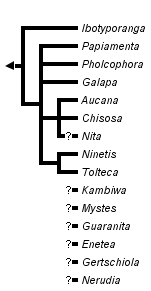Ninetines
Dimitar Dimitrov


This tree diagram shows the relationships between several groups of organisms.
The root of the current tree connects the organisms featured in this tree to their containing group and the rest of the Tree of Life. The basal branching point in the tree represents the ancestor of the other groups in the tree. This ancestor diversified over time into several descendent subgroups, which are represented as internal nodes and terminal taxa to the right.

You can click on the root to travel down the Tree of Life all the way to the root of all Life, and you can click on the names of descendent subgroups to travel up the Tree of Life all the way to individual species.
For more information on ToL tree formatting, please see Interpreting the Tree or Classification. To learn more about phylogenetic trees, please visit our Phylogenetic Biology pages.
close boxIntroduction
This group of pholcids includes several Old World and New World genera with globular abdomen and short legs. As a result of their small size and cryptic lifestyle ninetines are often overlooked and most of their biodiversity is probably unknown. Practically nothing is known about their biology.
Characteristics
Ninetines are small (1-2 mm) short legged pholcid spiders that live in the leaf litter or under stones and are often found in arid areas. Another character that is shared by all ninetine genera is the ninetine tarsal organ (Huber, 2000).
Discussion of Phylogenetic Relationships
All phylogenetic analyses which included ninetine genera placed them as the most basal pholcid members (e.g. Huber, 2000, 2001; Huber and El Hennawy, 2007; Bruvo-Madaric et al., 2005). Little is known about the ninetines' intergeneric relationships. The only study with a fairly large ninetine sample is that of Huber (2001) and his results, with additions to accommodate results from Huber and El Hennawy (2007), are used to represent ninetine relationships here.
Huber and Brescovit (2003) have suggested that monophyly of ninetines in Huber (2000) was supported by morphological characters that might not be independent and it was, thus, not “convincingly supported”. However, studies that used molecular data confirmed the monophyly of ninetines (Bruvo-Madaric et al., 2005).
References
Bruvo-Madaric B., Huber B.A., Steinacher A., Pass G. 2005. Phylogeny of pholcid spiders (Araneae:Pholcidae): combined analysis using morphology and molecules. Molecular Phylogenetics and Evolution 37: 661-673.
Huber B.A. 2000. New World pholcid spiders (Araneae: Pholcidae): a revision at generic level. Bull. Amer. Mus. Nat. Hist. 254: 1–348.
Huber B.A. 2001. The pholcids of Australia (Araneae; Pholcidae): taxonomy, biogeography, and relationships. Bulletin of the American Museum of Natural History 260: 1-144.
Huber B.A., Brescovit A.D. 2003. Ibotyporanga Mello-Leitão: tropical spiders in Brazilian semi-arid habitats (Araneae: Pholcidae). Insect Systematics and Evolution 34: 15-20.
Huber B.A., El Hennawy H. 2007. On Old World ninetine spiders (Araneae: Pholcidae), with a new genus and species and the first record for Madagascar. Zootaxa 1635: 45-53.
About This Page
Dimitar Dimitrov

Zoological Museum, University of Copenhagen
Correspondence regarding this page should be directed to Dimitar Dimitrov at
Page copyright © 2009 Dimitar Dimitrov
 Page: Tree of Life
Ninetines.
Authored by
Dimitar Dimitrov.
The TEXT of this page is licensed under the
Creative Commons Attribution-NonCommercial License - Version 3.0. Note that images and other media
featured on this page are each governed by their own license, and they may or may not be available
for reuse. Click on an image or a media link to access the media data window, which provides the
relevant licensing information. For the general terms and conditions of ToL material reuse and
redistribution, please see the Tree of Life Copyright
Policies.
Page: Tree of Life
Ninetines.
Authored by
Dimitar Dimitrov.
The TEXT of this page is licensed under the
Creative Commons Attribution-NonCommercial License - Version 3.0. Note that images and other media
featured on this page are each governed by their own license, and they may or may not be available
for reuse. Click on an image or a media link to access the media data window, which provides the
relevant licensing information. For the general terms and conditions of ToL material reuse and
redistribution, please see the Tree of Life Copyright
Policies.
- First online 12 February 2009
- Content changed 12 February 2009
Citing this page:
Dimitrov, Dimitar. 2009. Ninetines. Version 12 February 2009 (under construction). http://tolweb.org/Ninetines/135179/2009.02.12 in The Tree of Life Web Project, http://tolweb.org/





 Go to quick links
Go to quick search
Go to navigation for this section of the ToL site
Go to detailed links for the ToL site
Go to quick links
Go to quick search
Go to navigation for this section of the ToL site
Go to detailed links for the ToL site